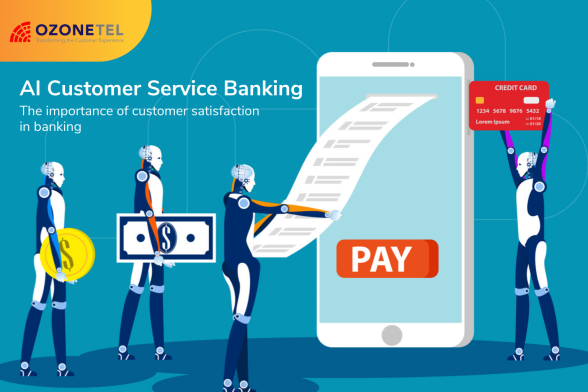- Resources
- AI Customer Service Banking
AI Customer Service Banking

The importance of customer satisfaction in banking
The banking sector has long suffered from commoditization. Products and services are almost all the same.
And with plenty of low and no-fee options, it’s near-impossible to compete on price alone.
Making things worse, are new tech upstarts offering piecemeal financial services. Amazon Cash, Apple Pay, WeChat, Cropin, and other non-traditional providers now offer core financial products like payments and underwriting.
There’s only one way to differentiate a brand when all the products and price points are virtually the same.
Quality of service experience.
It comes down to whether or not your customers are satisfied with the banking service they received.
McKinsey definitively found that banks with higher customer satisfaction ratings grow their deposits faster.
But what exactly is customer satisfaction? Can satisfaction be quantified?
Is a customer whose banking service is convenient and inobtrusive satisfied? Or do they need to feel wowed?
Should banking providers do the minimum? Or should they seek to push the envelope of stellar experiences?
Customer Satisfaction in the Banking Sector
Let’s take a step back and evaluate the customer’s general state of being.
First of all, they’re overall spoiled for choice. Not just in banking, everywhere. Netflix, Uber Eats, Instacart, Amazon Prime, etc. This makes them both fickle and convenience-oriented.
They’re used to omnichannel, personalized services that they can receive on their own time, whenever they want.
They’re likely experiencing a certain amount of emotional distress. Or at least have experienced distress in the past few months. Remember, this impacts even those who are doing well financially.
And your customers still need remote services with full capabilities.
To sum this up, banking customer satisfaction is defined by convenience, personalization, value-added services, comprehensive remote access, digital capabilities, and a touch of emotional consideration.
Quality of Service in the Banking Sector
The way that your bank meets (or fails to meet) these needs determines your quality of service.
Keep the SERVQUAL essentials for quality service in mind.
This is worth the trouble. Once perfected, customers will regard your bank as having premium service.
Then, they’ll reward you with their loyalty and their deposits. At least 84% more than any competitors with low customer satisfaction rankings.
These still provide a good guiding framework for service delivery:
- Tangibles – ambiance, first impressions, design, etc.
- Reliability – consistently reliable access to service whether physical or digital
- Assurance – how trustworthy are your digital channels, phone service, or in-person representatives
- Empathy – how well are they treated, do they feel embarrassed to speak with representatives, do they feel heard, etc.
- Responsiveness – how quickly are customers attended to, called back, or followed up on
How Artificial Intelligence is Used in Banking
Right now, banking is experiencing the same rapid digitalization process that’s disrupting almost every other sector.
Artificial intelligence is reconstructing the financial system’s entire infrastructure, bringing unprecedented new capabilities to the industry.
The financial industry is highly complex. AI’s advanced cognitive solutions are unlocking value throughout the banking sector.
Security
Security improvements might be one of the most dynamic applications for artificial intelligence in banking.
AI can employ voice recognition, cognition, predictive analysis, and biometrics. It can analyze mass quantities of data for fraud detection.
Risk Management
In early 2021, 56% of financial services providers reported using artificial intelligence for risk management.
According to Oliver Wyman, many service providers expect AI to completely alter the nature of financial asset risk management.
AI is taking over underwriting, despite any ethical concerns. AI-based underwriting can take a more holistic, present view of an applicant, rather than looking at their linear history, like traditional legacy-credit scoring models.
AI can also serve to support risky financial clients by noting behavioral patterns, offering advice, and warning their providers of risk.
Data Analytics & Decision Making
Leveraging AI for analytics, insights, and decision-making has the biggest impact on banking revenues.
This is according to the Global AI in Financial Services Survey from the Cambridge Centre for Alternative Finance (CCAF) and the World Economic Forum.
Security
Current applications include:
- Anti-money laundering
- Biometric fraud prevention
- Anomaly detection
- Transaction surveillance
Data Analytics & Decision Making
This is the most widespread use of artificial intelligence in banking.
- Hedge funders apply AI to their investment process
- FinTech start-ups apply machine learning to their datasets
- Mastercard uses AI to generate macroeconomic trend reports
AI in Banking Customer Service
Artificial intelligence should be used to enhance the overall banking customer experience.
AI understands context, behavioral patterns, and sentiment. These insightful capabilities into human nature should be used to deliver personalized and intuitively responsive service.
Predictive capabilities translate into need anticipation, offering service before clients realize they need it.
Conversational AI turns banking customer service chat into a naturally interactive, more useful experience.
Financial providers can differentiate themselves with helpful services, such as AI-assisted budgeting, goal planning, and debt management.
AI’s robotic process automation can improve service delivery in general, making it faster and error-free.
Self-service insurance or credit applications are integrating conversation AI to turn lengthy processes into engaging, guided experiences. This also guides them through friction points and prevents application drop-offs.
Artificial intelligence, machine learning, and other technologies, like electronic signatures, have slashed the amount of time needed to open a bank account. The gold standard for a digital bank opening process is only five minutes.
Two AI Banking Customer Service Case Studies
Bank of America
The Bank of America offers customers a “virtual financial assistant”, named “Erica”. It’s essentially an advanced customer service AI chatbot, built on a natural language processor.
It has a library of financial service chatlogs teaching it the terms and phrasing that customers use to talk about money.
Erica gets smarter and more knowledgeable as she engages with customers. She remembers them and improves her relationship-building skills over time.
Erica can lock and unlock credit cards, schedule human-to-human meetings, send bill reminders, alert customers when their bills will be higher, provide credit score advice, track spending, schedule payments, and help clients dispute charges.
Erica ramps up customer engagement, delivers increased value, and takes workload off BoA’s actual human support agents.
RBC’s Ownr
In Canada, RBC caters to business clients with an AI-powered platform that helps entrepreneurs register and incorporate businesses, then automate legal filings.
Ownr caters to solo proprietors, professionals, established corporations, and legal professionals.
The service is integrated with RBC’s banking offerings. Ownr users can get money back from registering a business when they sign up for a banking service.
They can sign up for an RBC account in person or complete the process fully online.
They also integrate with complementing services, like accounting software, tax preparation, shipping logistics, and more.
Advanced users can leverage document automation and automated government filing workflows with its open API.
AI’s Financial Impact
AI could easily deliver $1 trillion in value to the global banking industry.
This comes from increasing revenues via personalization, lowering costs through greater efficiency, and discovering new, still-unknown value-generating opportunities.
What does that look like for an individual provider?
Unfortunately for lawyers at JP Morgan & Chase, its machine-learning program named COIN (Contract Intelligence), powered through 360,000 hours (that’s 41 years) of legal work in a few seconds.
JP Morgan’s tech budget is just under $10 billion. This is 9% of its projected revenue (twice the industry’s average allotment).
What the bank saved on lawyer hours for this routine work, can be allotted to other, more high-value areas.
But JP Morgan’s COIN also slashed the number of loan-servicing mistakes made in the firm.
In 2015, a simple clerical error cost JP Morgan $1.5 billion. All because a lien was wrongfully included in loan processing documents for GM, way back in 2008.
AI and machine learning can prevent errors like this from reoccurring, saving billions more in value.
It’s hard to define exactly what AI’s financial impact can be, for even a single institution or service provider.
But current observations point to AI serving to enhance capabilities, make impersonal service more human, and tailor even large institutional services towards individual needs.
AI is delivering more than financial impacts and efficiency gains, it’s making the world around us more connected and intuitive.







